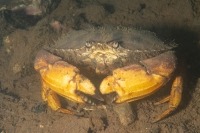
(Photo: Claire Goodwin)
Crabe nordique ou tourteau jona
Cancer borealis
Un crabe de couleur rosé à rouge-brique avec une carapace en forme d’éventail ayant une surface de texture rugueuse. De grandes pinces à bouts noirs. Les femelles sont plus petites que les mâles, atteignant environ 150 millimètres de large (carapace), et les mâles 220 millimètres. Tous les deux font à peu près 14 mues pour grandir.
L’autorité
Stimpson, 1859
La classification des détails
Embranchement: Arthropoda (arthropodes); Sous-embranchement: Crustacea (crustacés).
L’habitat
On les trouve sur la côte atlantique de l’Amérique du Nord, de Terre-Neuve à la Floride, de la zone intertidale jusqu’à une profondeur de plus de 800 mètres. Ses substrats préférés varient des fonds rocheux dans le golfe du Maine, à des fonds de limon et d’argile sur les pentes continentales.
L’alimentation
Ils mangent des proies, y compris les vers, les palourdes, les moules et les autres crabes. Ils se nourrissent aussi de charogne. Ils attrapent leur proie avec leurs grandes pinces avant de les déchiqueter avec leurs pièces buccales.
La reproduction
Les crabes nordiques peuvent être mâle ou femelle. Les mâles s’accouplent avec les femelles en transférant les spermatozoïdes à l’aide de leurs pattes modifiées à cet effet. L’accouplement se fait après la mue de la femelle, et elle garde le sperme pour une période indéfinie. La femelle pond ses œufs plus tard. Elle garde ses œufs sur son abdomen, sous la queue, pendant cinq à six mois. Les œufs éclosent éventuellement et des larves en sortent. Ces larves se nourrissent de plancton et nagent pendant des mois avant de se développer en petits crabes. Les crabes nordiques vivent environ huit ans.
Des faits amusants
Les crabes nordiques peuvent détecter la température de l’eau de mer autour d’eux, et si elle est trop élevée ou trop basse, les crabes migrent vers des régions plus confortables. Les crabes qui se sont développés dans des eaux plus chaudes préfèrent les températures plus élevées.
C’est souvent un défi de faire la différence entre le crabe nordique et son cousin, le crabe commun (Cancer irroratus). Il y a une expression en anglais qui dit ‘lisse comme une roche’ qui aide beaucoup; le crabe commun est parfois appelé crabe de roche, et il a une carapace lisse, contrairement à celle du crabe nordique, qui est rugueuse. Le crabe nordique a aussi des épines le long des extrémités des pinces, alors que la pince du crabe commun est lisse.
Références
Donahue MJ et al. (2009). Predation risk, prey, abundance and the vertical distribution of three brachyuran crabs on Gulf of Maine shores. Journal of Crustacean Biology 29, 523-531. Gulf of Maine Research Institute and University of Maine (2013) Jonah Crab (Cancer borealis) MSC Pre-assessment reports. Current status and information sources. Lewis L and Ayers J (2014) Temperature preference and acclimation in the Jonah Crab, Cancer borealis. Journal of Experimental Marine Biology and Ecology 455, 7-13. Pohle GW (1990) A guide to decapod crustacea from the Canadian Atlantic: Anomura and Brachyura. Canadian Technical Report of Fisheries and Aquatic Sciences 1771, 30 pp. Robichaud, DA and Frail C (2006) Development of Jonah crab, Cancer borealis, and rock crab, Cancer irroratus, fisheries in the Bay of Fundy (LFAs 35-38) and off southwest Nova Scotia (LFA 34): from exploratory to commercial status (1995-2004). Canadian Manuscript Report of Fisheries and Aquatic Science 2775: iii + 48 pp. Squires HJ (1990) Decapod crustacea of the Atlantic coast of Canada. Canadian Bulletin of Fisheries and Aquatic Sciences 221, 532 pp.

